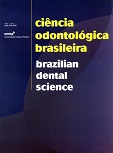Análise da infiltração apical de um novo cimento endodôntico a base de MTA
DOI:
https://doi.org/10.14295/bds.2009.v12i2.349Abstract
O MTA apresenta várias vantagens quando usado no selamento de perfurações e em obturações retrogradas Recentemente, um cimento endodôntico a base de MTA foi introduzido no mercado com o objetivo de obturar o canal radicular. Sendo assim, a proposta deste trabalho foi analisar o selamento apical do novo cimento Endo-CPM-Sealer® a base de MTA, comparando-o com outros cimentos de uso endodôntico. Para tanto, se valeu do modelo de infiltração do corante Rodamina B 1% em 44 dentes unirradiculares, divididos em 4 grupos experimentais (n=10) e 2 grupos controle (n=2) a saber: G1, AH-Plus®; G2, Endo-Rez®; G3, Endo-CPM-Sealer®; G4, Sealapex®; controle positivo sem cimento; controle negativo, AH-Plus e totalmente impermeabilizado. Após a instrumentação e obturação dos canais radiculares, as amostras foram impermeabilizadas, exceto o forame apical, e imersas no corante por 48 horas. Os cortes foram digitalizados para medição da infiltração linear do corante por meio do programa ImageLab. Os resultados da análise de infiltração apical, em ordem crescente, foram: AH-Plus® (0.495 mm) < Endo-Rez® (0.585 mm) < Sealapex® (0.776 mm)< Endo-CPM-Sealer® (1.032 mm). A análise estatística pelo teste de Kruskal-Wallis mostrou diferenças estatisticamente significantes entre AH-Plus® x Endo-CPM-Sealer® no nível de 0,1 %, AH-Plus® x Sealapex® no nível de 1% e Endo-CPM-Sealer® x Endo-Rez® no nível de 1%, não ocorrendo diferenças estatisticamente significativas entre as demais interações. Foi possível observar infiltração em todas as amostras, sendo que o cimento a base de MTA apresentou maior penetração de corante.
Downloads
Downloads
Published
How to Cite
Issue
Section
License
Brazilian Dental Science uses the Creative Commons (CC-BY 4.0) license, thus preserving the integrity of articles in an open access environment. The journal allows the author to retain publishing rights without restrictions.
=================




























